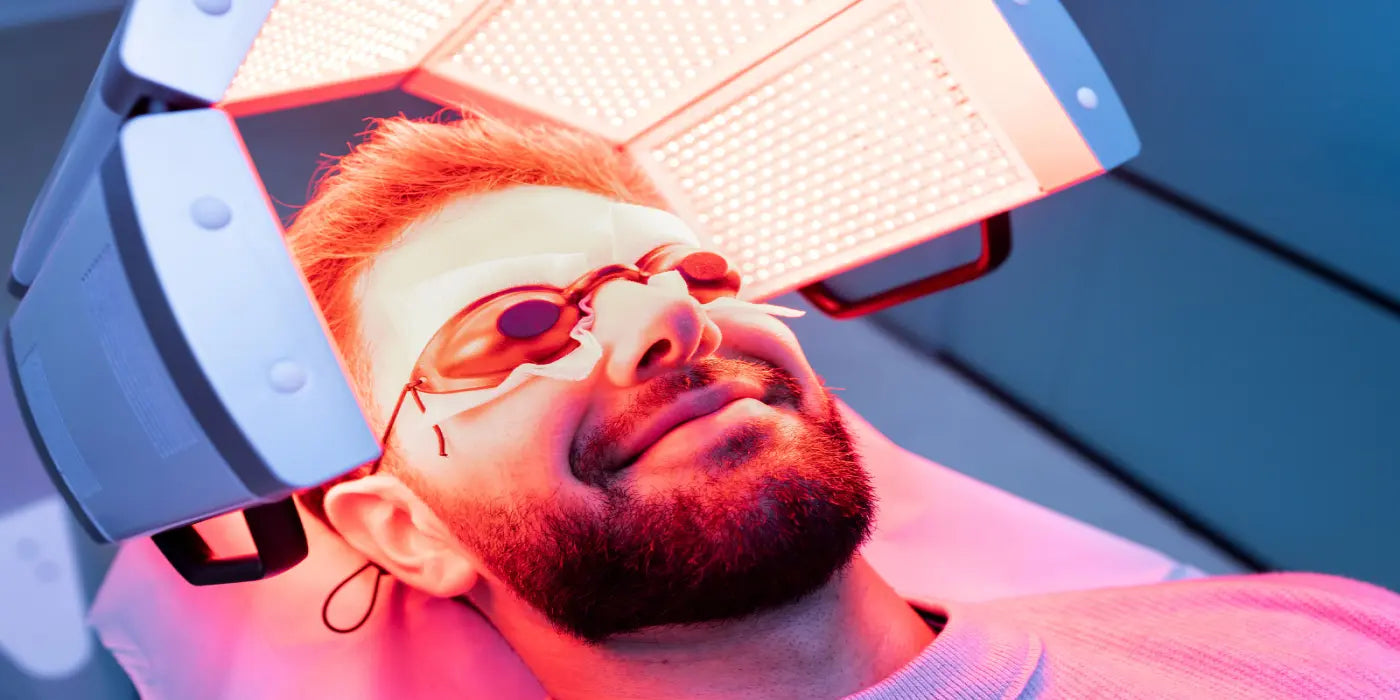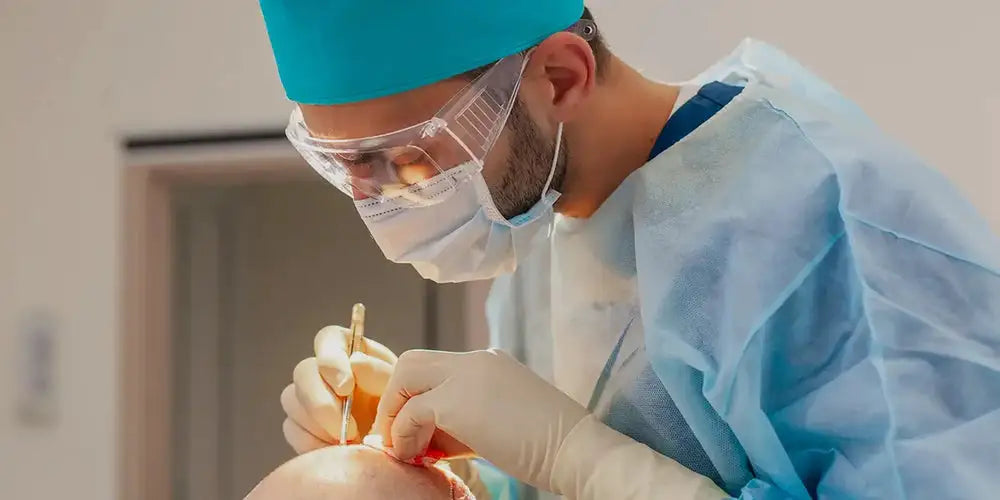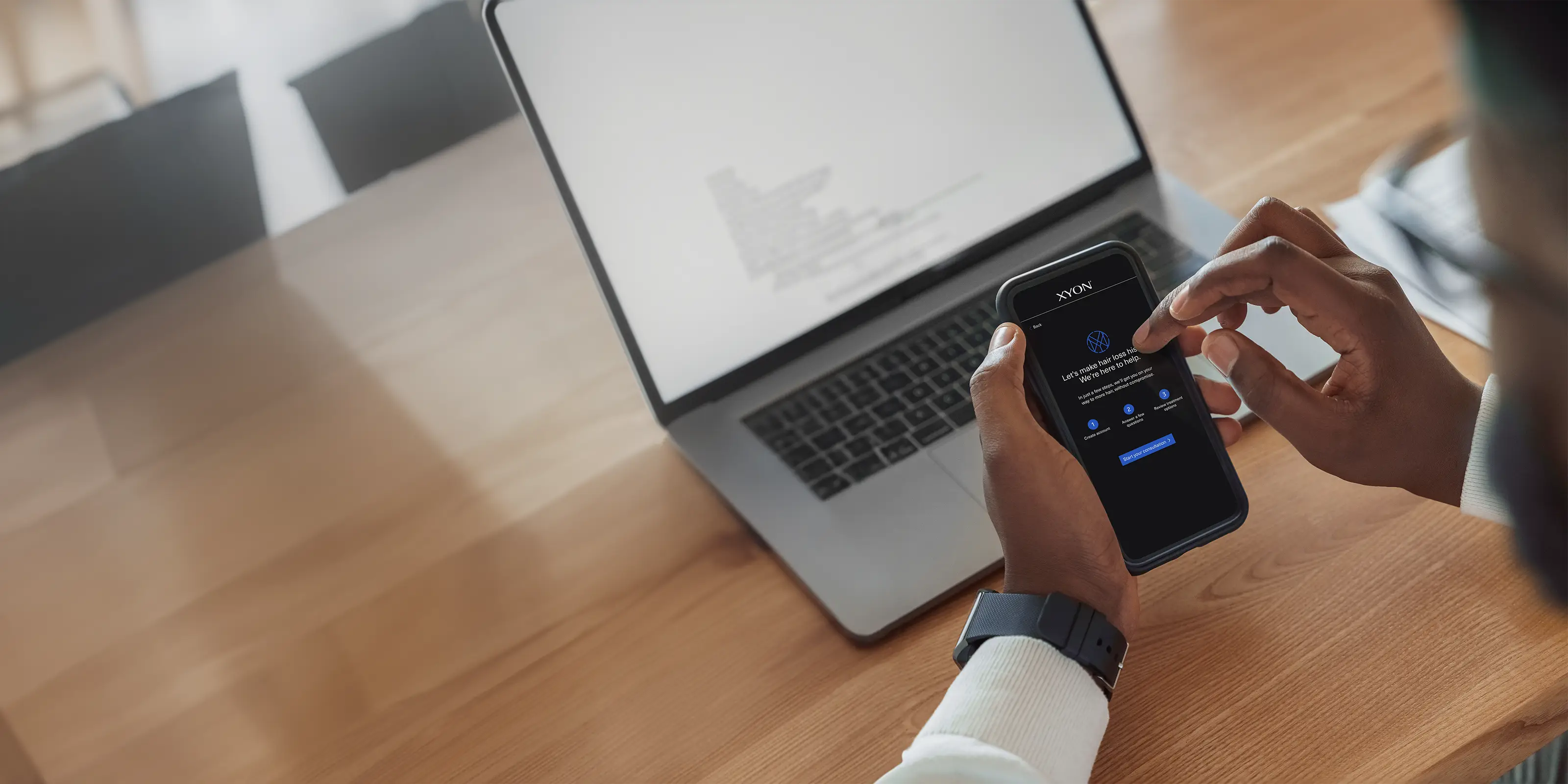Laser technology has countless applications in medicine and specifically dermatology. In addition to being beneficial to skin, there’s some evidence that red light therapy (also called low level laser therapy, or LLLT) could also be an effective tool to help treat androgenetic hair loss.
What is red light therapy (LLLT)?
Red light therapy is a type of photo biomodulation. Photo biomodulation involves using light, which is a form of energy, to stimulate biological processes such as hair growth and collagen production. There are a variety of devices including combs and helmets that can be used to deliver red light therapy and while some are FDA-approved, it’s important to be aware of other designations such as “FDA-cleared” or “FDA-registered”. The latter refers to devices that are sufficiently close in design to models that are already FDA-approved but haven’t been subjected to a formal pre-market approval process.
As for how often you’d need to use an at-home device or visit a clinic, this depends on the device, its properties and the type of hair loss you’re experiencing. Studies on LLLT have reported treatment durations ranging from 10 to 25 minutes at a frequency of 2-3 times per week for at least 16 weeks (Mineroff et al., 2024). You’ll need to follow the instructions that come with your device, or your clinic’s guidance.
Compared to lasers used in other medical applications, red light therapy tends to be weaker. The range of wavelengths commonly used for LLLT is between 630-800 nm (Mineroff et al., 2024) and therefore is not considered a true laser. This wavelength range corresponds to the color red in the visible spectrum of light and also is an ideal wavelength to penetrate the skin and the surrounding tissues, such as collagen and hair follicles and activate parts of cells responsible for generating energy.
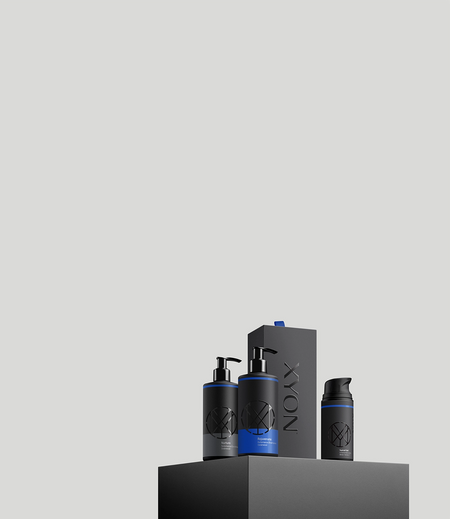
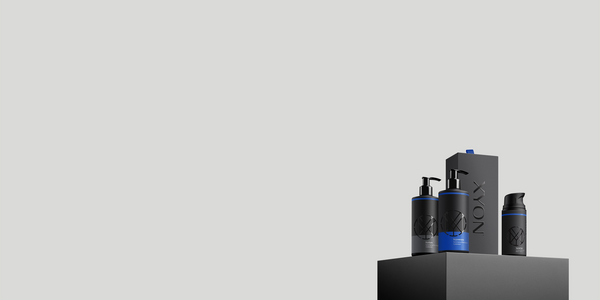
At XYON, we believe in choices when it comes to hair loss treatment.
Whether it's a shampoo or a prescription, we're committed to helping you find the right solution.
How does red light therapy work for hair loss?
One of the ways in which red light therapy can help with hair loss is by promoting cell growth. Because red light therapy delivers low energy in the setting of hair loss, their impact is mostly chemical, not thermal (they don’t generate significant heat).
While the exact mechanisms behind how light therapy works are still being studied, one theory is that the energy delivered by these lights are absorbed by cells, causing a chain reaction of chemical changes to occur. Cells end up using more oxygen which in turn produces more energy needed to drive the production of enzymes, growth factors and other proteins involved in hair growth and the hair growth cycle. In fact, there’s some evidence that red light therapy can stimulate and prolong the anagen, or active growth phase of the hair growth cycle (Sheen et al., 2015).
LLLT is also believed to promote blood circulation which benefits hair growth by increasing the delivery of oxygen and nutrients to the scalp and hair follicles. Red light and near infrared light stimulate the generation of new blood vessels via production of nitric oxide, a molecule that plays key roles in wound and tissue repair, as well as normal blood vessel function (Lohr et al., 2009).
Some clinical findings suggest that LLLT may also be beneficial in treating the autoimmune hair loss disorder alopecia areata due to its anti-inflammatory effects (Zhang et al., 2022). The increase in nitric oxide described above is thought to have trickle down effects on the release of cytokine and other inflammatory molecules (Pillai et al., 2021). It’s previously been established that controlling inflammation at the scalp is an important part of managing pattern hair loss and allowing hair regrowth to occur.
Is red light therapy good for hair loss? How effective is red light therapy?
Based on data from animal and human trials, red light therapy could be a reasonable alternative treatment for those suffering from several types of hair loss including pattern hair loss, alopecia areata and telogen effluvium (stress-related hair loss). It may not be sufficient as a standalone therapy but does seem to have some positive effects on hair growth.
Clinical data suggests that LLLT treatment can lead to an increase in hair diameter, density and the number of non-vellus hairs. Remember, non-vellus hairs can develop into mature terminal hairs, while vellus hairs, which tend to be lighter in color and more fragile, are a hallmark sign of androgenetic hair loss.
One large meta-analysis of the use of photo biomodulation for hair loss found that light treatment was superior to non-treatment controls. The analysis included 36 studies, totaling 966 patients suffering from alopecia areata or androgenetic alopecia (Zhang et al., 2022). Another meta-analysis involving 15 randomized controlled trials found that the average improvement in hair density with light treatment was 1.02 hairs/cm2 compared to no treatment (Gupta et al., 2021).
Let’s also consider how red-light therapy performs when compared to clinically proven treatments like minoxidil and in sham-controlled studies.
A study conducted by Esmat et al. compared the safety and efficacy of red-light therapy against 5% topical minoxidil and a combination of the two treatments in a cohort of female patients (2017). The groups receiving red light therapy were instructed to use it for 25 minutes a day, three times a week for four months. At the end of the study, dermascopic and biomicroscopic measurements showed that all three treatments increased hair diameter, but that combination treatment with red light therapy and topical minoxidil resulted in the highest perceived improvement in hair loss in doctors and patients.
The trend of increased patent satisfaction was also observed in another large randomized controlled trial in men and women who used a comb device three times a week for 26 weeks (Jimenez et al., 2014). Compared to those who were in the sham treatment group, more subjects who received active treatment reported improvement in hair loss, as well as thicker and fuller hair.
Another randomized, double-blinded and sham-controlled study conducted in 2013 asked subjects to use a low-level laser helmet for 24 weeks (Kim et al., 2013). Men and women with androgenetic hair loss were enrolled and the results of the study showed that average hair thickness and density, when assessed using phototrichograms, significantly improved with LLLT. However, in contrast to the studies noted above, there wasn’t a significant visual, or perceived improvement in hair loss between treatment groups.
Can I use red light therapy with other forms of hair loss treatment?
We consulted our medical director Dr. Christina Han, Medical Director for her opinions on whether red light therapy can and should be combined with other hair loss treatments and specifically, topical formulas:
"There is a sparsity of evidence when it comes to combining red light therapy with topical hair loss treatments for androgenetic alopecia. The overall evidence in terms of clinical efficacy remains good but inconsistent without definitive guidelines on how LLLT should be utilized for pattern hair loss.
What is common though, and realistic, is for physicians to use combination therapy to treat androgenetic hair loss due to the nature of this condition being difficult to treat. Combining multiple modalities of therapy, especially those that have differing mechanisms of action, can increase the chances of a good treatment response.
Therefore, for those who are considering using LLLT as part of their hair growth regimen along with their topical prescription treatment, I would recommend using it at a different time point, for example, 4 hours after applying your medication.
The frequency of LLLT can vary, but as an example, if sessions are 10-25 minutes long and patients are doing this 2-3 times a week, it could be relatively easily incorporated into a routine that already includes topical finasteride and minoxidil or topical dutasteride."
Do you ever personally recommend LLLT to your patients?
"Yes, I do recommend LLLT on occasion. However, I would add that pharmaceutical treatments, such as minoxidil and finasteride, have stronger evidence to support their efficacy so I maintain that pharmaceutical treatment should be the priority for patients when treating their hair loss. I consider red light therapy to be an emerging adjunctive treatment that could be beneficial for the right patient(s), but more evidence is needed for me to confidently recommend this as a form of monotherapy for hair loss."
Is red light therapy safe?
"Generally, light therapy is safe, but there are some things to keep in mind. Transient redness, skin pain and blistering have been reported in the literature. Patients with darker skin are at a higher risk of experiencing these side effects, especially at higher fluences (energy settings). Also, at-home LED devices do have the potential to cause retinal (eye) damage, so additional studies are needed to evaluate the short and long-term exposure risks of at-home LEDs. Purchasing from a reputable manufacturer and following the instructions can minimize any potential risks."
Takeaway: Red light therapy for hair loss
For people who are interested in a non-invasive, non-medicated solution for thinning hair, red light therapy could be an option. Studies show that it can help stimulate hair growth and may even assist in regulating the hair growth cycle with minimal side effects.
However, available data does not suggest that it’s more effective as a standalone therapy than existing clinically proven solutions like finasteride, dutasteride or minoxidil. As it stands, LLLT’s usefulness lies in it being an adjunctive (add on) therapy.
If you are interested in using an at-home device such as a comb or helmet, it’s important to familiarize yourself with the manufacturer’s instructions for use to minimize any potential safety risks.
Want to connect with a doctor to learn more about your options for treating hair loss? We’re committed to making that process as easy as possible and offering reassurance along the way. Start your hair growth journey today.
References:
Avci, P., Gupta, G. K., Clark, J., Wikonkal, N., & Hamblin, M. R. (2014). Low-level laser (light) therapy (LLLT) for treatment of hair loss. Lasers in Surgery and Medicine, 46(2), 144–151. https://doi.org/10.1002/lsm.22170.
Esmat, S. M., Hegazy, R. A., Gawdat, H. I., Hay, R. M. A., Allam, R. S., Naggar, R. E., & Moneib, H. (2017). Low level light‐minoxidil 5% combination versus either therapeutic modality alone in management of female patterned hair loss: A randomized controlled study. Lasers in Surgery and Medicine, 49(9), 835–843. https://doi.org/10.1002/lsm.22684.
Farivar, S., Malekshahabi, T., & Shiari, R. (2014). Biological effects of low level laser therapy. Journal of Lasers in Medical Sciences, 5(2), 58–62.
Gupta, A. K., & Carviel, J. L. (2019). Meta-analysis of photobiomodulation for the treatment of androgenetic alopecia. Journal of Dermatological Treatment, 32(6), 643–647. https://doi.org/10.1080/09546634.2019.1688755.
Hamblin, M. R. (2017). Mechanisms and applications of the anti-inflammatory effects of photobiomodulation. AIMS Biophysics, 4(3), 337-361. https://doi.org/10.3934/biophy.2017.3.337.
Jimenez, J. J., Wikramanayake, T. C., Bergfeld, W., Hordinsky, M., Hickman, J. G., Hamblin, M. R., & Schachner, L. A. (2014). Efficacy and safety of a low-level laser device in the treatment of male and female pattern hair loss: a multicenter, randomized, sham device-controlled, double-blind study. American Journal of Clinical Dermatology, 15(2), 115–127. https://doi.org/10.1007/s40257-013-0060-6.
Kim, H., Choi, J. W., Kim, J. Y., Shin, J. W., Lee, S., & Huh, C. (2013). Low-Level light therapy for androgenetic alopecia: a 24-Week, Randomized, Double-Blind, SHAM Device–Controlled Multicenter trial. Dermatologic Surgery, 39(8), 1177–1183. https://doi.org/10.1111/dsu.12200.
Mineroff, J., Maghfour, J., Ozog, D. M., Lim, H. W., Kohli, I., & Jagdeo, J. (2024). Photobiomodulation CME part II: Clinical applications in dermatology. Journal of the American Academy of Dermatology, 91(5), 805–815. https://doi.org/10.1016/j.jaad.2023.10.074.
Pillai, J. K., & Mysore, V. (2021). Role of Low-Level Light Therapy (LLLT) in Androgenetic Alopecia. Journal of Cutaneous and Aesthetic Surgery, 14(4), 385–391. https://doi.org/10.4103/JCAS.JCAS_218_20.
Sheen, Y. S., Fan, S. M., Chan, C. C., Wu, Y. F., Jee, S. H., & Lin, S. J. (2015). Visible red light enhances physiological anagen entry in vivo and has direct and indirect stimulative effects in vitro. Lasers in Surgery and Medicine, 47(1), 50–59. https://doi.org/10.1002/lsm.22316.
Zhang, Y., Su, J., Ma, K., Fu, X., & Zhang, C. (2022). Photobiomodulation Therapy With Different Wavebands for Hair Loss: A Systematic Review and Meta-Analysis. Dermatologic Surgery, 48(7), 737–740. https://doi.org/10.1097/DSS.0000000000003472.

